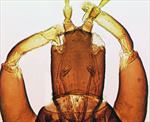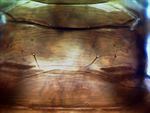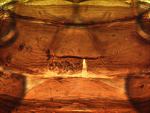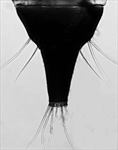
Female

Antenna

Male head & fore legs

Female mesonotum, metanotum & pelta

Male mesonotum, metanotum & pelta

Female abdominal segments IX–X (tube)
Both sexes wingless. Body legs and antennae dark brown; major setae pale. Antennae 8-segmented; segment III with 2 sense cones, IV with 3 sense cones; segment VIII slender but broad at base. Head longer than wide, projecting slightly in front of eyes, cheeks convex; eyes angular with straight external margins, narrowed and prolonged ventrally; postocular setae bluntly pointed, longer than dorsal length of eye; maxillary stylets broad, not retracted as far as postocular setae, wide apart and V-shaped. Pronotum with 4 pairs of softly pointed major setae, anteromarginals small; epimeral sutures complete; basantra small, ferna transverse, mesopresternum degenerate. Fore tarsi with no tooth. Metanotum transverse, with one pair of long setae. Pelta broad, posterior margin eroded medially in male; tergites without sigmoid wing-retaining setae; tergite IX setae finely acute, almost as long as tube.
Large male with fore femora stout, fore tibia with small lobe at inner apex, and fore tarsal tooth large.
The genus Bolothrips comprises 17 species worldwide, almost all Holarctic, with two species from South Africa, one from Tristan da Cunha, and four from North America, of which only one is known from California (Mound & Palmer, 1983). B. rhachiphilus is similar in appearance to B. pratensis Hood from Texas, but is uniformly dark brown instead of bicolored (Mound, 1974).
Probably breeding at the base of grasses; feeding by imbibing fungal spores.
Known only from California.
PHLAEOTHRIPIDAE, IDOLOTHRIPINAE
Bolothrips rhachiphilus Cott
Bolothrips rhachiphilus Cott, 1956: 181.
Mound LA (1974) The Nesothrips Complex of Spore-Feeding Thysanoptera (Phlaeothripidae: Idolothripinae). Bulletin of the British Museum (Natural History). Entomology 31: 109–188.
Mound LA & Palmer JM (1983) The generic and tribal classification of spore-feeding Thysanoptera (Phlaeothripidae: Idolothripinae). Bulletin of the British Museum (Natural History). Entomology 46: 1–174.